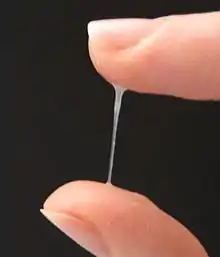Billings ovulation method
The Billings ovulation method is a method in which women use their vaginal mucous to determine their fertility.[3] It does not rely on the presence of ovulation, rather it identifies patterns of potential fertility and obvious infertility within the cycle, whatever its length. Effectiveness, however, is not very clear.[3]
| Billings ovulation method | |
|---|---|
| Background | |
| Type | Behavioral |
| First use | developed in 1950s |
| Failure rates (first year) | |
| Perfect use | 0.5–3[1][2]% |
| Typical use | 1–22[1]% |
| Usage | |
| Reversibility | immediate |
| User reminders | Accurate teaching and daily charting are essential. |
| Clinic review | None |
| Advantages and disadvantages | |
| STI protection | No |
| Period advantages | Prediction |
| Weight gain | No |
| Benefits | Low cost, no prerequisites for use, no side effects, can aid pregnancy achievement |
| Risks | Nil |
Evidence
Evidence of effectiveness is not very clear.[3] Typical use of this method is associated with a pregnancy rate of 1 to 22%.[1] A World Health Organization study found that 15% is caused by a conscious departure from method rules.[1] The percentage of people who stop using the method after a year is between 1 and 24%.[1] Perfect use has been estimated to result in pregnancy in 0.5 to 3%.[1][2] Some studies of perfect use excluded those who could not detect secretions that represented fertility.[1]
Fertility


- A woman ovulates at only one time during her cycle, and an unfertilised ovum can survive for only 12–24 hours.
- Cervical mucus enabling healthy sperm cells to navigate the genital tract is necessary for fertility.
- Most commonly, spermatozoa live only one to three days in the presence of fertile mucus, with survival up to five days being rare. The possibility of pregnancy from sperm survival longer than five days has been compared to "the chances of winning a huge lottery."[4]
- Menstruation will occur about 2 weeks after ovulation.
- A ten-year study of 45,280 subfertile couples in China found that 32.1% of women were able to achieve pregnancy and live birth through the use of Billings.[5]
Function
In the days leading up to ovulation the cervix responds to oestrogen by producing mucus capable of sustaining sperm survival. This mucus leaves the vagina as the woman is in an upright position. The mucus is observed through the sensation at the vulva and by looking at any cervical secretions. Daily charting of these observations will reveal either an unchanging pattern indicating infertility or a changing pattern of sensation and discharge indicating fertility. Both of these patterns follow the hormonal patterns which control sperm survival and conception.[6]
History
The first recorded observations of the relationship between cervical mucus and survival of spermatozoa come from the mid-19th century. The topic was not systematically studied, however, for almost another century. In 1948, Erik Odeblad was studying mycoplasms in the female genital tract. During the course of his studies, he noticed that cervical mucus changed in a predictable pattern through the course of a woman's cycle. He continued his study of the cervix.[7]
John Billings (1918–2007) was involved with the development of the Billings ovulation method.[8]
References
- Pallone, SR; Bergus, GR (2009). "Fertility awareness-based methods: another option for family planning". Journal of the American Board of Family Medicine. 22 (2): 147–57. doi:10.3122/jabfm.2009.02.080038. PMID 19264938.
- Hatcher, Robert Anthony; M.D, Anita L. Nelson (2007). Contraceptive Technology. Ardent Media. p. 345. ISBN 9781597080019.
- Jr, Dudley L. Poston; Bouvier, Leon F. (2010). Population and Society: An Introduction to Demography. Cambridge University Press. p. 91. ISBN 9781139489386.
- Kippley, John; Sheila Kippley (1996). The Art of Natural Family Planning (4th ed.). Cincinnati, OH: The Couple to Couple League. p. 88. ISBN 978-0-926412-13-2.
- China Successfully Launching Billings Method Archived December 30, 2006, at the Wayback Machine: Dr. Shao-Zhen Qian
- Teaching the Billings Ovulation Method, Dr E. L. Billings AM, MB BS, DCH (London), 2001.
- Odeblad, Erik (1994). "The Discovery of Different Types of Cervical Mucus". Bulletin of the Ovulation Method Research and Reference Centre of Australia. 21 (3): 3–35. Archived from the original on 2005-12-20. Retrieved 2006-10-19.
- Billings, J (2002). "THE QUEST - leading to the discovery of the Billings Ovulation Method". Bulletin of Ovulation Method Research and Reference Centre of Australia. 29 (1): 18–28. Archived from the original on 2007-02-19.
External links
- http://billings.life/ Official site] of the Billings Ovulation Method
- http://www.jabfm.org/content/29/4/508.full.pdf+html The Performance of Fertility Awareness-based Method Apps Marketed to Avoid Pregnancy
- https://billingsmentor.org/fabmApps.pdf Fertility Awareness-based Method Apps for the Billings Method